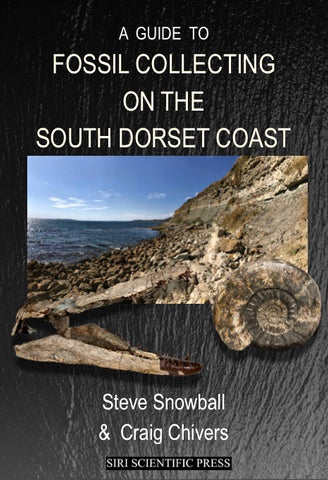New title in prep: A Guide to Fossil Collecting on the South Dorset Coast
Posted by David Penney on
Following on from the success of our recent title: A Guide to Fossil Collecting on the West Dorset Coast, we are pleased to announce that a second volume is now in preparation: A Guide to Fossil Collecting on the South Dorset Coast by the same authors and illustrator. We expect this volume to be ready by the end of the year or early next.

See below for more information on the first volume or click the cover to go to the product page and order a copy.
Reviews
Deposits Magazine (2018, issue 56, page 43, snippets): This newly published guide is another near-perfect fossil book from Siri Scientific Press, who are rapidly becoming my favourite publisher of esoteric palaeontology. … As a guide for amateurs on the geology, history of collecting and palaeontology of this part of the British coast, this guide is hard to beat. … Best of all are the numerous full colour photos of the fossils themselves, to allow identification, and the beautiful artistic interpretations of what the Triassic and Jurassic seas may have looked like by Andreas Kurpisz. … I would definitely recommend this book for anyone who has been to West Dorset to collect fossils or anyone who is intending to go. It is also worth owning just to admire the pictures.
Everything Dinosaur Blog: At a conference in a rather chilly Helsinki held seventeen years ago this week, delegates of the World Heritage Committee of the United Nations Educational, Scientific and Cultural Organisation (UNESCO), confirmed that World Heritage Site status would be conferred upon a 95-mile stretch of the coastline of southern England covering the east Devon and Dorset coast.
In the minutes of the conference, the reason for this award was recorded:
“The Dorset and East Devon Coast provides an almost continuous sequence of Triassic, Jurassic and Cretaceous rock formations spanning the Mesozoic Era, documenting approximately 185 million years of Earth history. It also includes a range of internationally important fossil localities – vertebrate and invertebrate, marine and terrestrial – which have produced well-preserved and diverse evidence of life during Mesozoic times.”
However, this description does not convey the true majesty of this location, nor does it provide a sense of awe that this part of the British Isles inspires in so many people. Neither does it do justice to the simple pleasure of finding a fossil, gazing at it and realising that you are the first living creature in 180 million years to set eyes upon the petrified remains of what was once another inhabitant of our planet.
Then a book is published, a book that provides a sense of the stunning natural landscape, a book that transports the reader back in time, a book that conveys the sense of excitement and achievement associated with fossil collecting – “A Guide to Fossil Collecting on the West Dorset Coast” – does all this and more.
Drawing on their detailed knowledge of fossil collecting, Craig and Steve describe what to look for and where to find an array of fossil specimens along this part of the “Jurassic Coast”. The landscape is vividly portrayed and the book provides a handy, rucksack-sized reference for fossil collectors, whether seasoned professionals or first time visitors to Dorset. The Book is Filled with Stunning Photographs of Fossil Discoveries.
Talented palaeoartist Andreas Kurpisz provides readers with digital reconstructions of ancient environments and brings to life the fossil specimens, showing them as living creatures interacting with other prehistoric animals in a series of Jurassic landscapes and seascapes. These reconstructions help to document the changing environments that are now preserved within the imposing cliffs of this remarkable part of the British coastline.
From the back cover
This is a guide on the safe and responsible collection of fossils along the beautiful and often wild section of West Dorset’s Jurassic Coast.
This sumptuously illustrated book, in full colour throughout, provides invaluable advice for the fossil collector. It contains up-to-date information regarding the geology, the exposures and the fossils themselves, making this a ‘must-have’ guide to browse through at leisure, or as an invaluable aid to any forthcoming field trip to the many locations that are so vividly described.
The landscape and fossil photographs are exquisite and often quite breath-taking, with superb reconstructions of Jurassic life by Andreas Kurpisz.
Steve Snowball was the co-author of ‘A Guide to Fossil Collecting in England & Wales’. Craig Chivers is an experienced fossil preparator of the highest order. This book reflects their huge experiences within the area of West Dorset, in which they live and collect.
Contents
ACKNOWLEDGEMENTS
FOREWORD BY THE AUTHORS
1. INTRODUCING THE JURASSIC COAST: A World Heritage Site
The Eroding Coast
The Protected Coast: The West Dorset Code of Conduct
2. SHE SELLS SEA SHELLS: Mary Anning and Her Legacy
3. THE WEST DORSET SUCCESSION
4. TOOLS, EQUIPMENT & PREPARATION
5. FOSSIL COLLECTING EXCURSIONS IN WEST DORSET
EXCURSIONS AROUND LYME REGIS
Blue Lias Formation: Pinhay Bay, Chippel Bay, Monmouth Beach & Church Cliffs
Charmouth Mudstone Formation: The Spittals & Black Ven
EXCURSIONS AROUND CHARMOUTH
Charmouth Mudstone Formation: East Beach, Stonebarrow & Broom Cliff
EXCURSIONS AT SEATOWN
Charmouth Mudstone Formation: Golden Cap & Ridge Cliff
EXCURSIONS AROUND EYPE
Dyrham Formation: East Ebb Cove, Thorncombe Beacon to
Eype Mouth
Dyrham Formation: Eype Mouth to Watton Cliff
EXCURSIONS AROUND BURTON BRADSTOCK
Inferior Oolite Group: East Cliff, West Bay to Burton Cliff
& Cliff End, Burton Bradstock
6. MUSEUMS AND GALLERIES
Charmouth Heritage Centre
Lyme Regis Museum
Bridport Museum
Dinosaurland, Lyme Regis
7. BIBLIOGRAPHY
8. ABOUT THE AUTHORS
9. INDEX OF FOSSILS ILLUSTRATED
Foreword by the authors
The collection of fossils along the West Dorset coast has been a fascination for over two hundred years and there’s certainly no sign of abatement. Indeed, every year and especially during the summer months, thousands of tourists visit the area. At this time of year and on a daily basis, seemingly every fossil in sight will have been picked up from the beaches along this particular stretch of the coast. By the very nature and composition of the rocks, combined with a staggeringly rapid rate of erosion, the replenishment of fossils contained within them is never in short supply. It’s a small wonder that it’s a popular place for fossil enthusiasts and during the winter months it comes into its own as a source of spectacular specimens.
The rocks here are exclusively composed of sediments laid down in marine environments of varying depths and over the course of between 166.1 to 201.3 million years ago. Mostly these are dominated by fine-grained mudrocks—clays, shales and marls—as displayed in the rocks of the Lower Lias between Lyme Regis and Seatown but are also composed of oolitic limestone, clays and sandstones shown in the majestic cliffs near Burton Bradstock.
This coast is undoubtedly one of the best sources of marine Jurassic-aged fossils in the world. It’s also an area world famous for its beautiful scenery, its history and its contribution to our understanding of life in deep time. The discovery of fossil specimens, hitherto unknown, is often the raison d’être for many collectors, perhaps wishing to contribute in some small way to the filling of gaps in the fossil record. For others, it is the sheer enjoyment of finding an organism that is so incredibly old and yet so tantalisingly beautiful that it often sets them on a path to find out more about our fragile planet and its past and possibly to a lifetime hobby of fossil collecting.
This UNESCO World Heritage Site has SSSI (Site of Special Scientific Interest) designation, which emphasises the need for care and consideration when collecting. The collector, amateur and professional alike, has to adopt a responsible approach in order to help make significant advances to the study of fossils and to demonstrate that fossil collecting is essential, especially if specimens (some of which may be of great scientific value) are to be saved from damage or destruction by the sea. Collecting offers an opportunity for people to learn about the ancient past and to contribute to our understanding of it. The discovery of new finds can only give further insight to a time that only a fertile mind might imagine and whilst it is inevitable that thousands of fossil specimens are bound to be lost to the relentless tides, the dedication of the few and the enthusiasm of the many can help to restore the delicate balance between destruction and preservation.
We hope that this book will inspire the safe and responsible collection of fossils from undoubtedly a truly beautiful part of Britain and provide an insightful read in the process.
Steve Snowball & Craig Chivers
2018
Share this post
- 1 comment
- Tags: Forthcoming title, News
1 comment


Hi Steve,
Just to let know my wife and I have Injoied reading your last book.
If you’re next book is enjoyable as the first I would like to pre-order two of your new books, as I understand it wrong be much longer before it’s out on realise.
Yours sincerely
Mr DENNIS Radbourne.